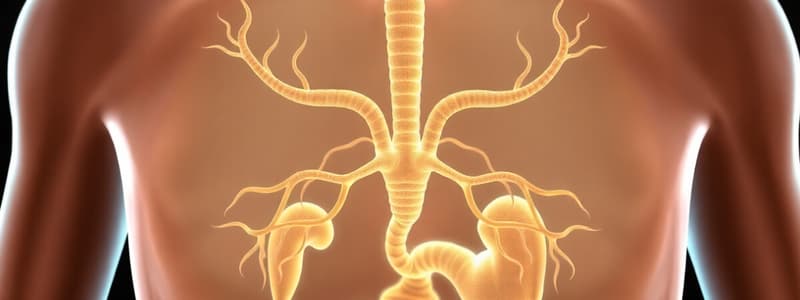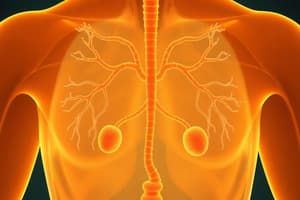Podcast
Questions and Answers
What primarily stimulates insulin secretion?
What primarily stimulates insulin secretion?
- Decreased blood amino acids
- Increased blood glucose concentration (correct)
- Decreased blood glucose concentration
- Increased sympathetic nervous activity
Type I diabetes mellitus is primarily due to insulin resistance in target cells.
Type I diabetes mellitus is primarily due to insulin resistance in target cells.
False (B)
What is the function of glucagon in relation to glucose levels?
What is the function of glucagon in relation to glucose levels?
It increases blood glucose levels by promoting glycogenolysis and gluconeogenesis.
The _________ nervous system increases insulin secretion, while the ___________ nervous system decreases it.
The _________ nervous system increases insulin secretion, while the ___________ nervous system decreases it.
Match each hormone with its function:
Match each hormone with its function:
What is the primary function of the adrenal glands?
What is the primary function of the adrenal glands?
The pancreas is not involved in nutrient metabolism.
The pancreas is not involved in nutrient metabolism.
What are the two main types of reactions in fuel metabolism?
What are the two main types of reactions in fuel metabolism?
The liver and skeletal muscles store excess circulating glucose as __________.
The liver and skeletal muscles store excess circulating glucose as __________.
Match the following organs or glands with their primary function:
Match the following organs or glands with their primary function:
Which hormone is primarily responsible for lowering blood glucose levels?
Which hormone is primarily responsible for lowering blood glucose levels?
The brain can store glycogen to regulate its glucose supply.
The brain can store glycogen to regulate its glucose supply.
What is the primary role of insulin in the body?
What is the primary role of insulin in the body?
Fatty acids are the preferred source of energy for muscle cells during the absorptive state.
Fatty acids are the preferred source of energy for muscle cells during the absorptive state.
Which hormone is secreted by the alpha cells of the pancreas?
Which hormone is secreted by the alpha cells of the pancreas?
Amino acids can be converted to glucose through a process called __________.
Amino acids can be converted to glucose through a process called __________.
Match the metabolic states with their descriptions:
Match the metabolic states with their descriptions:
Which glucose transporter is only responsive to insulin?
Which glucose transporter is only responsive to insulin?
The pancreas's epsilon cells produce insulin.
The pancreas's epsilon cells produce insulin.
What is the primary site for amino acid storage in the body?
What is the primary site for amino acid storage in the body?
During the __________ state, metabolic fuels are mobilized.
During the __________ state, metabolic fuels are mobilized.
What effect does glucagon have on blood glucose levels?
What effect does glucagon have on blood glucose levels?
Flashcards
Fuel Metabolism
Fuel Metabolism
All chemical reactions within the body's cells. It specifically involves the breakdown, synthesis, and transformation of proteins (amino acids), carbohydrates (sugars), and lipids (fats).
Anabolism
Anabolism
The process of building larger molecules from smaller ones. This requires energy in the form of ATP.
Catabolism
Catabolism
The process of breaking down larger molecules into smaller ones. This releases energy in the form of ATP.
Glucose Storage
Glucose Storage
Signup and view all the flashcards
Brain's Glucose Dependence
Brain's Glucose Dependence
Signup and view all the flashcards
Insulin's Role
Insulin's Role
Signup and view all the flashcards
Glucagon's Role
Glucagon's Role
Signup and view all the flashcards
Insulin and Blood Glucose
Insulin and Blood Glucose
Signup and view all the flashcards
Insulin's Stimuli
Insulin's Stimuli
Signup and view all the flashcards
Insulin Deficiency and Diabetes
Insulin Deficiency and Diabetes
Signup and view all the flashcards
Insulin and Glucagon Team
Insulin and Glucagon Team
Signup and view all the flashcards
Fuel for the brain
Fuel for the brain
Signup and view all the flashcards
Gluconeogenesis
Gluconeogenesis
Signup and view all the flashcards
Excess Fatty Acid Storage
Excess Fatty Acid Storage
Signup and view all the flashcards
Amino Acid Storage
Amino Acid Storage
Signup and view all the flashcards
Absorptive State
Absorptive State
Signup and view all the flashcards
Postabsorptive State
Postabsorptive State
Signup and view all the flashcards
Insulin's Effect on Glucose Transporters
Insulin's Effect on Glucose Transporters
Signup and view all the flashcards
Insulin's Influence on Fat Metabolism
Insulin's Influence on Fat Metabolism
Signup and view all the flashcards
Insulin and Amino Acid Storage
Insulin and Amino Acid Storage
Signup and view all the flashcards
Study Notes
Peripheral Endocrine Glands
- Endocrine glands control fuel metabolism, calcium metabolism, and the functions of adrenal and thyroid glands.
- Endocrine pancreas metabolizes nutrients.
- Parathyroid glands are important for calcium metabolism.
- Adrenal glands metabolize nutrients, adapt to stress, and maintain salt balance.
- Thyroid controls the body's basal metabolic rate.
Fuel Metabolism
- Metabolism encompasses all chemical reactions within body cells.
- Fuel metabolism (intermediary metabolism) involves the degradation, synthesis, and transformation of proteins, carbohydrates, and lipids.
- Digestion breaks down macromolecules into absorbable subunits.
Fuel Metabolism (Continued)
- Anabolism synthesizes large organic molecules, requiring ATP.
- Catabolism breaks down large molecules, creating ATP.
- Hydrolysis and oxidation reactions create ATP.
- Smaller subunits from catabolism fuel energy and cellular synthesis.
Nutrient Storage: Glucose
- Nutrients from meals are stored and released.
- Excess glucose is stored as glycogen in the liver and skeletal muscles.
- Glycogen storage is limited; excess glucose is stored as triglycerides in adipose tissue.
- The brain requires a constant glucose supply and cannot store glycogen.
- During fasting, many body cells use fatty acids to conserve glucose for the brain.
- Amino acids can be converted to glucose by gluconeogenesis to supply the brain.
Nutrient Storage: Fatty Acids and Amino Acids
- Excess circulating fatty acids are incorporated into triglycerides primarily in adipose tissue.
- Excess amino acids are converted to glucose and fatty acids, ultimately becoming triglycerides in adipose tissue.
- Muscle tissue is the primary storage site for amino acids, utilized for structural proteins.
Nutrient Storage and Use
- Two metabolic states exist: absorptive (fed) and postabsorptive (fasting).
- The absorptive state occurs when nutrients are absorbed into the blood after meals (approximately 4 hours).
- During this state, metabolic fuels are stored.
- The postabsorptive state occurs between meals when nutrient absorption ceases.
- During this state, stored molecules are broken down to maintain glucose concentration and provide energy.
Insulin Stimulation
- Insulin lowers blood glucose, fatty acid, and amino acid levels.
- Insulin facilitates glucose transport into cells using specific glucose transporters (GLUTs), particularly GLUT-4.
- Insulin stimulates glycogen synthesis in skeletal muscles and the liver.
- Insulin inhibits glycogenolysis and gluconeogenesis.
- Insulin promotes the conversion of glucose to fatty acids and the transport of fatty acids into adipose tissue, and promotes the incorporation of amino acids into cells to synthesize proteins.
- Insulin secretion increases with increased blood glucose during the absorptive state.
- Insulin secretion decreases if glucose levels drop to below a normal level and shifts the metabolism to the postabsorptive state.
Insulin Secretion
- Glucose, amino acids, and gastrointestinal hormones stimulate insulin release.
- Parasympathetic stimulation and blood amino acids increase insulin release.
- Blood glucose, fatty acids, amino acids, protein synthesis, and fuel storage are all regulated by insulin.
Glucagon
- Glucagon's actions are opposite to those of insulin.
- Glucagon promotes glycogenolysis and gluconeogenesis.
- Glucagon increases fat breakdown.
- Glucagon promotes protein breakdown, primarily in the liver.
- Glucagon secretion increases during the postabsorptive state.
- Glucagon secretion increases when blood glucose is low.
- Glucagon, along with other hormones like growth hormone, cortisol, and epinephrine, acts as an antagonist to insulin in raising blood glucose levels.
Studying That Suits You
Use AI to generate personalized quizzes and flashcards to suit your learning preferences.
Related Documents
Description
This quiz explores the functions of various peripheral endocrine glands, including the pancreas, parathyroid, and adrenal glands, in regulating metabolism and nutrient storage. It also covers the processes of anabolism and catabolism as they relate to energy production. Test your knowledge on how these systems interact and contribute to overall health.


